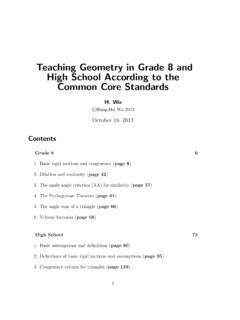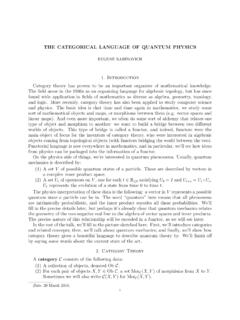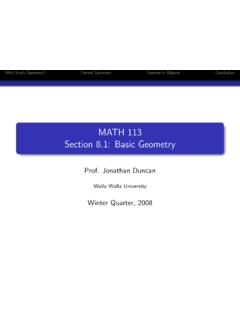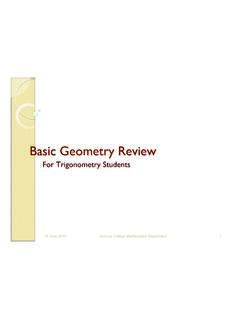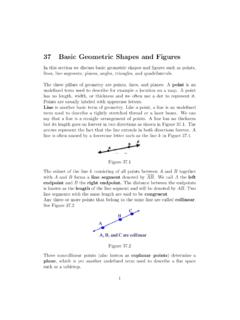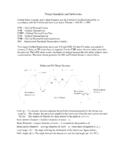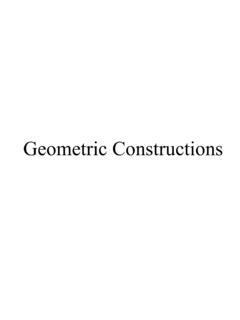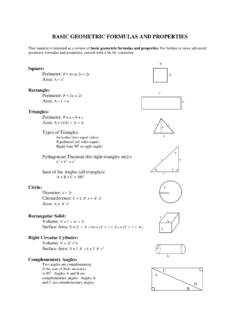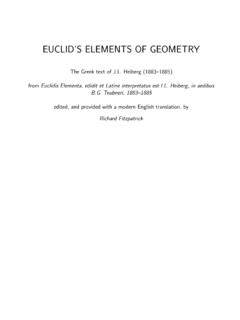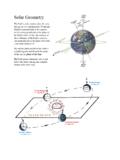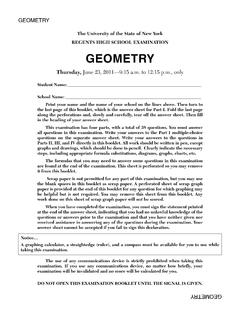Transcription of The Foundations of Geometry - UCB Mathematics
1 TheFoundations of GeometryBYDAVID HILBERT, PH. OF Mathematics , UNIVERSITY OF G TTINGENAUTHORIZED TRANSLATIONBYE. J. TOWNSEND, PH. OF ILLINOISREPRINT EDITIONTHE OPEN COURT PUBLISHING COMPANYLA SALLEILLINOIS1950 TRANSLATION material contained in the following translation was given in substance by Professor Hilbertas a course of lectures on euclidean Geometry at the University of G ttingen during the wintersemester of1898 1899. The results of his investigation were re-arranged and put into the formin which they appear here as a memorial address published in connection with the celebrationat the unveiling of the Gauss-Weber monument at G ttingen, in June,1899. In the Frenchedition, which appeared soon after, Professor Hilbert made some additions, particularly in theconcluding remarks, where he gave an account of the results of a recent investigation made byDr.
2 Dehn. These additions have been incorporated in the following a basis for the analysis of our intuition of space, Professor Hilbert commences his discus-sion by considering three systems of things which he calls points, straight lines, and planes, andsets up a system of axioms connecting these elements in their mutual relations. The purposeof his investigations is to discuss systematically the relations of these axioms to one anotherand also the bearing of each upon the logical development of euclidean Geometry . Among theimportant results obtained, the following are worthy of special mention:1. The mutual independence and also the compatibility of the given system of axioms isfully discussed by the aid of various new systems of Geometry which are The most important propositions of euclidean Geometry are demonstrated in such amanner as to show precisely what axioms underlie and make possible the The axioms of congruence are introduced and made the basis of the definition of The significance of several of the most important axioms and theorems in the develop-ment of the euclidean Geometry is clearly shown; for example, it is shown that the whole of theeuclidean Geometry may be developed without the use of the axiom of continuity.
3 The signifi-cance of Desargues s theorem, as a condition that a given plane Geometry may be regarded as apart of a Geometry of space, is made apparent, A variety of algebras of segments are introduced in accordance with the laws of development and discussion of the foundation principles of Geometry is not only ofmathematical but of pedagogical importance. Hoping that through an English edition theseimportant results of Professor Hilbert s investigation may be made more accessible to Englishspeaking students and teachers of Geometry , I have undertaken, with his permission, this trans-lation. In its preparation, I have had the assistance of many valuable suggestions from ProfessorOsgood of Harvard, Professor Moore of Chicago, and Professor Halsted of Texas. I am alsounder obligations to Mr. Henry Coar and Mr. Arthur Bell for reading the J. TownsendUniversity.
4 1 CHAPTER FIVE GROUPS OF AXIOMS. 1. The elements of Geometry and the five groups of axioms ..2 2. Group I: Axioms of connection ..2 3. Group II: Axioms of Order ..3 4. Consequences of the axioms of connection and order ..5 5. Group III: Axiom of Parallels (Euclid s axiom) ..7 6. Group IV: Axioms of congruence ..8 7. Consequences of the axioms of congruence ..10 8. Group V: Axiom of Continuity (Archimedes s axiom) ..15 CHAPTER COMPATIBILITY AND MUTUAL INDEPENDENCE OF THE AXIOMS. 9. Compatibility of the axioms ..17 10. Independence of the axioms of parallels. Non-euclidean Geometry ..19 11. Independence of the axioms of congruence ..20 12. Independence of the axiom of continuity. Non-archimedean geometry21 CHAPTER THEORY OF PROPORTION. 13. Complex number-systems ..23 14. Demonstration of Pascal s theorem ..25 15. An algebra of segments, based upon Pascal s theorem.
5 30 16. Proportion and the theorems of similitude ..33 17. Equations of straight lines and of planes ..35 CHAPTER THEORY OF PLANE AREAS. 18. Equal area and equal content of polygons ..38 19. Parallelograms and triangles having equal bases and equal altitudes .40 20. The measure of area of triangles and polygons ..41 21. Equality of content and the measure of area ..44 CHAPTER S THEOREM. 22. Desargues s theorem and its demonstration for plane geometryby aid of the axioms of congruence ..48 23. The impossibility of demonstrating Desargues s theorem for theplane without the help of the axioms of congruence ..50 24. Introduction of an algebra of segments based upon Desargues s theoremand independent of the axioms of congruence ..53 25. The commutative and the associative law of addition for our newalgebra of segments ..55 26. The associative law of multiplication and the two distributive lawsfor the new algebra of segments.
6 56 27. Equation of the straight line, based upon the new algebra of segments ..61 28. The totality of segments, regarded as a complex number system ..64 29. Construction of a Geometry of space by aid of adesarguesian number system ..65 30. Significance of Desargues s theorem ..67 CHAPTER S THEOREM. 31. Two theorems concerning the possibility of proving Pascal s theorem ..68 32. The commutative law of multiplication for anarchimedean number system ..68 33. The commutative law of multiplication for anon-archimedean number system ..70 34. Proof of the two propositions concerning Pascal s Geometry ..72 35. The demonstration, by means of the theorems of Pascal and Desargues,of any theorem relating to points of intersection ..73 CHAPTER CONSTRUCTIONS BASED UPON THE AXIOMS I V. 36. Geometrical constructions by means of a straight-edge and atransferer of segments.
7 74 37. Analytical representation of the co-ordinates of pointswhich can be so constructed ..76 38. The representation of algebraic numbers and of integral rational functionsas sums of squares ..78 39. Criterion for the possibility of a geometrical construction by means ofa straight-edge and a transferer of segments ..80 Conclusion ..83 All human knowledge begins with intu-itions, thence passes to concepts and endswith ideas. Kant,Kritik der reinen Vernunft, Ele-mentariehre, Part2, , like arithmetic, requires for its logical development only a small number ofsimple, fundamental principles. These fundamental principles are called the axiomsof Geometry . The choice of the axioms and the investigation of their relations to oneanother is a problem which, since the time of Euclid, has been discussed in numerousexcellent memoirs to be found in the mathematical problem is tanta-mount to the logical analysis of our intuition of following investigation is a new attempt to choose for Geometry asimpleandcompleteset ofindependentaxioms and to deduce from these the most important geomet-rical theorems in such a manner as to bring out as clearly as possible the significance ofthe different groups of axioms and the scope of the conclusions to be derived from theindividual the comprehensive and explanatory report of G.
8 Veronese,Grundz ge der Geometrie, Ger-man translation by A. Schepp, Leipzig,1894(Appendix). See also F. Klein, Zur ersten Verteilung desLobatschefskiy-Preises, Math. Ann., FIVE GROUPS OF AXIOMS. ELEMENTS OF Geometry AND THE FIVE GROUPS OF us consider three distinct systems of things. The things composing the first system,we will callpointsand designate them by the lettersA,B,C,.. ; those of the second,we will callstraight linesand designate them by the lettersa,b,c,.. ; and those of thethird system, we will callplanesand designate them by the Greek letters , , ,.. Thepoints are called theelements of linear Geometry ; the points and straight lines, theelementsof plane Geometry ; and the points, lines, and planes, theelements of the Geometry of spaceortheelements of think of these points, straight lines, and planes as having certain mutual rela-tions, which we indicate by means of such words as are situated, between, paral-lel, congruent, continuous, etc.
9 The complete and exact description of these rela-tions follows as a consequence of theaxioms of Geometry . These axioms may be arrangedin five groups. Each of these groups expresses, by itself, certain related fundamentalfacts of our intuition. We will name these groups as follows:I,1 7. Axioms ,1 5. Axioms ofparallels(Euclid s axiom).IV,1 6. Axioms ofcontinuity(Archimedes s axiom). I: AXIOMS OF axioms of this group establish a connection between the concepts indicated above;namely, points, straight lines, and planes. These axioms are as follows:I, distinct points A and B always completely determine a straight line a. We writeAB=a or BA= of determine, we may also employ other forms of expression; for example,we may sayA lies upon a,A is a point of a,a goes through A and through B,a joins A and or with B, etc. IfAlies uponaand at the same time upon anotherstraight lineb, we make use also of the expression: The straight lines a and b havethe pointAin common, , two distinct points of a straight line completely determine that line; that is, if AB=aand AC=a, where B6=C, then is also BC= , points A, B, C not situated in the same straight line always completely determine aplane.
10 We write ABC= employ also the expressions:A,B,C, lie in ;A,B,C are points of , , three points A, B, C of a plane , which do not lie in the same straight line, completelydetermine that , two points A, B of a straight line a lie in a plane , then every point of a lies in .In this case we say: The straight linealies in the plane , , two planes , have a point A in common, then they have at least a second point B , every straight line there exist at least two points, in every plane at least three pointsnot lying in the same straight line, and in space there exist at least four points not lyingin a I,1 2contain statements concerning points and straight lines only; that is,concerning the elements of plane Geometry . We will call them, therefore, theplane axiomsof group I, in order to distinguish them from the axioms I,3 7, which we will designatebriefly as thespace axiomsof this the theorems which follow from the axioms I,3 7, we shall mention only thefollowing:Theorem 1.
